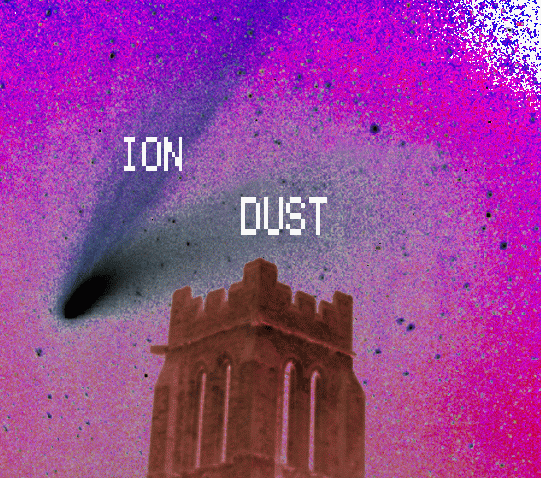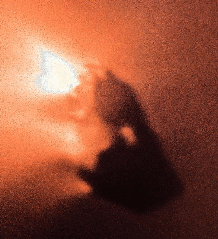There are two main types of cometary tail.
The Ion Tail (Type I)
The neutral gas species in cometary comae can be ionised by solar UV photons, as in
 . The ions are susceptible to a
magnetic force due to the solar magnetic field carried by the solar wind.
Consequently, the ions are swept out of the coma into a
long, distinctive ion tail. Because the most common
ion, CO+, scatters blue light better than red, the ion tail often appears
to the human eye as blue. Also, the magnetic force is very strong and
produces ropes, knots and streamers that distinguish the ion tail from the
dust tail. The solar wind sweeps past the comet at about 500 km/s,
causing the ion tail to be swept almost exactly in the anti-solar direction.
. The ions are susceptible to a
magnetic force due to the solar magnetic field carried by the solar wind.
Consequently, the ions are swept out of the coma into a
long, distinctive ion tail. Because the most common
ion, CO+, scatters blue light better than red, the ion tail often appears
to the human eye as blue. Also, the magnetic force is very strong and
produces ropes, knots and streamers that distinguish the ion tail from the
dust tail. The solar wind sweeps past the comet at about 500 km/s,
causing the ion tail to be swept almost exactly in the anti-solar direction.

Click on the Figure for a true color version
The Dust Tail (Type II)
The dust tail consists of dust particles that have been pushed out of the
coma by
radiation pressure from the sun.
Compared to the ION tail, the dust
tail is morphologically diffuse, and appears white or slightly pink (because
the dust grains reflect sunlight slightly better at longer wavelengths than
at shorter wavelengths). The dust particles in the tail are individually in
orbit about the sun, each with slightly less attraction to the sun than the
nucleus because of the effect of radiation pressure. This causes the dust
tail to be curved as the comet swings around the sun.
Both the ion and the dust tails can attain great lengths, up to about an Astronomical Unit (10^11 m) in the most spectacular cases.
Last updated August 2009
 |
 |
|
| Nucleus | Comet | Jewitt |
|---|